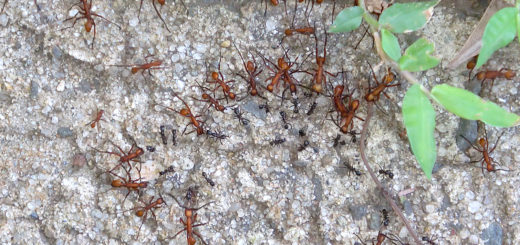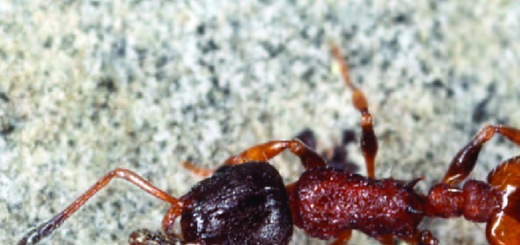Nest architecture in the fire ant Solenopsis invicta

© Walter R. Tschinkel
Interview with Walter Reinhart Tschinkel
Walter Reinhart Tschinkel was born on 15 September 1940 in what is today the Czech Republic. He and his family emigrated to the United States in 1946, where he studied biology and focused first on chemical communication and chemical defence of tenebrionid beetles. He started his research career in 1975 at Florida State University, retired after 43 years of teaching and research, and is today Professor emeritus of Florida State University. Walter R. Tschinkel focussed on the fire ant Solenopsis invicta. He published the famous book “The fire ants”, which was nominated for the Pulitzer Prize, and he coined the term “insect sociometry” (Tschinkel 1991). In this interview, we talk about his paper “Testing the effect of a nest architectural feature in the fire ant Solenopsis invicta (Hymenoptera: Formicidae)” (Tschinkel 2018) published recently in Myrmecol. News.
An Interview compiled by Patrick Krapf 
MNB: Thank you, Dr. Tschinkel, that you take time to give us an interview. Could you tell as a bit about yourself as a researcher?
WRT: I began my research career looking at chemical communication and chemical defence in beetles. When I started working at the Florida State University, I started working with chemical communication and chemical defence in ants. It was at this time when my interest in ants broadened through the time as a faculty member. Around the time of my retirement, I was very generally interested in life history of ants.
Today, I am still continuing with research on ant nest architecture, but I am no longer applying for grants – I did not like that part of being a researcher anyway. My last funding ended in July 2017, but I have a little bit of money left from the time when I sold aluminium casts to several museums around the world. I use this money now for my research, which is now only field based, and I use things like scrap, charcoal, and plaster. So, my work is cheap and I can do it all by myself. The work done in this paper was also my last laboratory experiment.
MNB: Could you briefly outline the background for your study and your motivation for it?
WRT: In his paper “Reproductive efficiency in relation to colony size in hymenopterous societies” (Michener 1964), Michener stated that the larger an ant colony, the less efficient it is at producing new ants. Many of us, including me, did not read the paper as critically as we maybe should have. So it became a generally accepted truth that in social insect colonies, the brood rearing efficiency was less efficient in big colonies. In the 1980s, Sanford Porter, a PhD student of mine, observed the same thing. When ant colonies were brought to the laboratory, they were less efficient in rearing new ants in any way measured, for example, number or weight. The weight of new ants per ant per month was lower for a larger S. invicta colony than for a smaller colony. In the 1990s, I performed a large observational study in the field. I collected entire colonies in the seasonal cycles, measured them and computed the ratio of workers to pupae (e.g., new ants emerging in a week or less). The ratio was one and did not change with size of the colony, meaning that small and large colonies had the same rearing efficiency. That seemed to contradict the findings of our previous studies in the laboratory. This troubled me for a long time, and since I had lot of experience with S. invicta, it seemed to be a fruitful experiment to try.
MNB: Could you briefly outline your research on nest-architectural features in the fire ant S. invicta?
WRT: A nest of a field colony is composed of hundreds of small chambers, and the size of the work group per chamber (which is about 200 ants) is probably constant because the size of the chambers does not change. The hypothesis of this paper was that laboratory colonies decline in ant rearing efficiency because laboratory colonies are bigger than actual chambers in the field. Over the years, I offered this project to several undergraduate students, but due to their schedules and workload, it was always complicated to conduct. So I decided to do this experiment right when I retired, with the help of a technician, Nicholas Hanley. He did the experiment twice, in 2016 and 2017. In both experiments, we assigned the colonies into two treatments and installed them in plaster nests with either one single big chamber or with 48 smaller chambers of the same total area. No matter how we measured, there was no effect on brood-rearing efficiency.
MNB: What was the biggest obstacle you had to overcome in this project?
WRT: The complexity of proper measurement techniques and measurement efficiency. The physical aspects for the study are straight forward – you need pla ster nests, ants (and getting them is easy), and 45 years of experience with fire ants helps a lot, but the measures were complicated. There are always differences with such measurements: Estimating the brood rearing efficiency is difficult, workers die in between, and you have to decide whether you include this into the data. You look for an instantaneous – in the sense of a few days – production capacity. A perfect set of measures would be kind of a daily estimate of brood and of workers so that you could integrate that measure over time. But for practical reasons, you measure the total production at the end of one brood cycle, which creates the problem accounting for worker mortality. However, values in both assays (2016 and 2017) were so similar that it seems unlikely that it was a problem. So it seems that the experiment tells us something real.
ster nests, ants (and getting them is easy), and 45 years of experience with fire ants helps a lot, but the measures were complicated. There are always differences with such measurements: Estimating the brood rearing efficiency is difficult, workers die in between, and you have to decide whether you include this into the data. You look for an instantaneous – in the sense of a few days – production capacity. A perfect set of measures would be kind of a daily estimate of brood and of workers so that you could integrate that measure over time. But for practical reasons, you measure the total production at the end of one brood cycle, which creates the problem accounting for worker mortality. However, values in both assays (2016 and 2017) were so similar that it seems unlikely that it was a problem. So it seems that the experiment tells us something real.
MNB: Could you do this experiment on a daily basis?
WRT: Theoretically yes. You could count the ants every day; and we tried something like that in 2016. We took images and tried to count the brood and workers, but workers often bunched together, so you cannot really count them. Moreover, there are some other practical problems, but if you assume that mortality of workers is similar in the two treatments (smaller and big chambers), the final weight of the colony is a decent measure.
MNB: During this project, what was the most frustrating moment?
WRT: Nicholas and I used to collect the colonies on Florida State University campus where they occur abundantly along roadsides. Usually, we collect them in winter (December or January) when the soil is cool. The sun then warms the soil, and queen, workers, and brood come up to the mound, and one can collect them quite effectively. In the years past, our capture rate of queens was 50% or better. In 2016 and 2017, however, the capture rate was much lower, likely because we experienced such warm winters, and the ants do not segregate like that by temperature in the morning. We had to go through a large numbers of colonies before we captured enough queens so that we could set up the experiment. So, that was kind of frustrating.
MNB: What was the moment you enjoyed most?
WRT: I really like to make gadgets and build things. I enjoyed making those plaster nests and setting the experiment up.
MNB: What is the take-home message of this project?
WRT: The obvious message is that this aspect of nest architecture does not have the function of making the colony more efficient. What I like people to take home is the question behind it. Considering the variety of architecture that we see in ant species, the question is, why do they make different nests? What does the architecture itself do that has such an important effect on the colony function – that is ultimately the question that we need to answer with studying nest architecture. A broader message is that I would like it if more people were to start working on nest architecture. But there are only a few people that even consider it. Laboratory nests are almost always artefacts. Single chamber or two-chamber nests in constant conditions likely introduce artefacts in life-history and behaviour of ants. Those are some obvious artefacts that would be great if people were to start dealing with them.
MNB: Do you have any tip for other researchers who are interested in doing related research?
WRT: In Myrmecological News, I published an article that kind of summarises the tips (Tschinkel 2011). I believe natural history is important. A detailed knowledge of the natural history of social insects that people work with is really important. It is a wellspring of good questions about social insects. Somehow, doing natural history studies has fallen out of fashion, unfortunately. I would like to see people going back to doing the kind of detailed natural history studies that I did with fire ants. Such studies are extremely illuminating. You can theorize as much as you want, but then you are only testing a hypothesis rather than making a lot of detailed observations. You then end up answering that hypothesis which might be only a very small fraction of what you could have gotten from a good, detailed observation study.
Science is driven by fashion, just like lots of other fields are, and molecular and genetic methods have their place and can be powerful tools for answering certain kinds of questions, but when the field is too unbalanced, that is not so good. When everybody is doing genetic and molecular studies and nobody is doing natural observation studies, that is not good for the field or the future. The real questions come out of natural history. And the ultimate questions that we are trying to answer are how and why are the ants or the bees doing what they do? There might be a genetic component to that, but you first have to describe what they do. And you have to understand it in the context of the colony life history and of the seasons and maybe of the environment and so on and so forth. That’s all just basic natural history. And it is more fun than sitting in the lab and squirting fluids into tiny little tubes (laughs).
MNB: Where do you see the future for this particular field of ant research?
WRT: I don’t know what the future will be. It depends on whether other people start working in this field, and so far, there are only very few. Just simply doing an occasional study would not have a major impact on the field. It would have to be somebody who concentrates on the nest architecture as a field of the study. The ultimate questions are why and especially how do ants build these underground structures? How do they organize the work structure to do that? There are some people who work on that but largely in a theoretical manner in the laboratory, and ants do not build natural nests in the laboratory. I established that a long time ago, and nests in the laboratory do not look like anything from the field. What we want to know is how does the colony self-organize so that it produces these quite species-typical structures?
MNB: Do you want to add anything?
WRT: Maybe a reflection.
I was fortunate to have this career during a particular time. I had the luxury of pursuing questions and findings in whatever direction I wanted. It was kind of almost a scientific career of high purity. Whatever I found would raise the next question, and I was able to pursue it if I wanted, and I often did. I have the feeling nowadays that there is more constraint largely because research is driven by funding. I never had that problem; I was funded continuously from 1971 until 2017. And even so, some of my major work was actually not funded, but I just did it. I guess the desirable way for a scientific career to work is to be driven by curiosity. I was able to follow my curiosity quite freely during my entire career. I wonder whether there is a kind of modern anxiety driven by funding and by getting a job and so on and so forth. In a sense, I was lucky because when I started, science was expanding rapidly. I got a job easily, and money was available. I guess young people seem to fear that they are not free to do whatever they want. They cannot simply pursue their curiosity. They have to conform or have to do certain things in order to get jobs and to get money and funding; but I am now an observer from a more distant place (laughs).
MNB: Dear Dr. Tschinkel, thank you again for this interview. Have a nice day.
WRT: Thank you, and I wish you the best.
References
Michener, C.D. 1964: Reproductive efficiency in relation to colony size in hymenopterous societies. – Insectes Sociaux 11: 317-341.
Tschinkel, W.R. 1991: Insect sociometry, a field in search of data. – Insectes Sociaux 38: 77-82.
Tschinkel, W.R. 2011: Back to basics: sociometry and sociogenesis of ant societies (Hymenoptera: Formicidae). – Myrmecological News 14: 49-54.
Tschinkel, W.R. 2018: Testing the effect of a nest architectural feature in the fire ant Solenopsis invicta (Hymenoptera: Formicidae). – Myrmecological News 27: 1-5.





Recent Comments